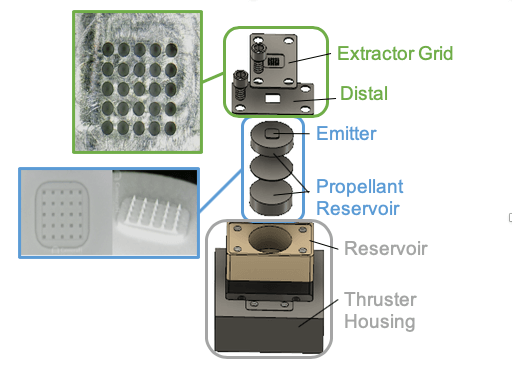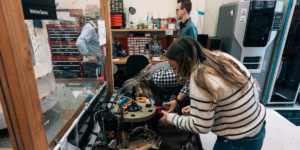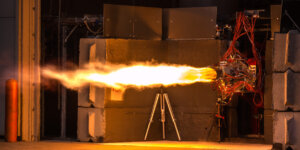
Image of a nanosatellite orbiting the Earth. IMAGE/ Rick Jo.
There are more than 2,600 satellites that orbit the Earth today. They range in size from as big as a school bus to as small as a Rubik’s cube. The more compact of these are becoming increasingly intriguing to space explorers, who cite cost, ease of assembly and ease of launch as key factors in their use. Given how light they are, a rocket could carry several of these smaller satellites with them, without needing extra fuel.
SmallSat and CubeSat missions, which utilize these more compact satellites, are critically hindered by the lack of propulsion systems that can apply adequate thrust within strict volume constraints. At lower orbits, this means satellites might simply burn up over time. At higher orbits, they could end up as space trash, taking years to degrade and eventually causing enough clutter to interfere with space exploration.
A team of students from the USC Laboratory for Exploration and Astronautical Physics (LEAP), including Robert Antypas and Jeffrey Asher, doctoral students in the Viterbi Department of Astronautical Engineering. The students are working to optimize the design of ionic electrospray thrusters, in-space propulsion devices, in collaboration with the Air Force Research Laboratory (AFRL). These thrusters are small, light and powerful, easy to construct and customizable. These unique aspects contributed to the team winning first place in the AIAA Small Satellite Poster Competition. The students were supervised by Joseph Wang, professor of astronautics and aerospace and mechanical engineering at the USC Viterbi School of Engineering.
Said Asher: “Unlike traditional electric or chemical propulsion technologies, these thrusters are able to scale linearly with the area by increasing the number of emission sites.” In other words, you can increase the level of thrust outputted by increasing the number of emitter tips on the device, a feature not currently possible on other types of propulsion technologies.
The CubeSat standard is widely used within the astronautics and aerospace community for enabling inexpensive space missions, as well as platforms for technology demonstration in space.
“Currently these CubeSats are launched to space as ride-along payloads, and are jettisoned off in whatever orbit the prime mission is heading to,” Asher said. “The ability to integrate propulsion into these small satellites allows satellite designers more flexibility when determining launchers and overall mission complexity, because the spacecraft can actively change what orbit it is in.” Asher said that integrating propulsion also enables small spacecrafts the ability to de-orbit more quickly to reduce space debris.
Design
The ionic electrospray thruster the team created is an electrostatic propulsion device that operates by extracting and accelerating ions from the propellant using an electric field. The ion extraction is aided by the thruster’s use of a novel liquid propellant, called an ionic liquid. This liquid is highly conductive and freely “gives up” its charge when exposed to an electric field. It also has extremely low vapor pressure, so that it can withstand being directly exposed to the vacuum conditions of space without evaporating.

Construction and primary components of USC Testbed Thruster. Image/Jeffrey Asher.
To aid in the ion extraction, the ionic liquid needs a well-defined emission site. To achieve this, tiny emitter tips are micromachined into a porous glass substrate. Propellant is able to wick through the pores of this glass and when it is exposed to the high electric field between the tip and extractor grid, ions are expelled, generating thrust.
The thrusters being tested at LEAP measure approximately 1x1x0.5 inches. Traditional propulsion technologies are challenging to scale down to such a small form, so this new technology offers an efficient option for propulsion for a small spacecraft.
The team worked within the constraints of a CubeSat platform. CubeSats can range in size from 100mm cubes up to approximately 300-500mm cubes—for example the size of a tissue box to that of a small microwave. Antypas, the lead tester and designer on the project, led much of the initial testing.
Testing and Next Steps
This work was severely affected by the COVID-19 shutdown. Luckily, Antypas, an astronautical engineering doctoral student, had completed a lot of thruster testing before the USC campus shutdown. Given an inability to work in lab during this past April as planned, Asher decided to pivot the emphasis of the poster to the subsystem sizing requirements. He hopes to be able to get back into lab later in the fall. To prepare, Asher has also been working with Paulina Piekarewicz, a USC Viterbi sophomore merit scholar who has been assisting with constructing test equipment.
The team is now working to package the equipment used in the lab on a single circuit board, which can be flown on a future spacecraft demonstration and operate the thrusters. Once this is achieved, the team will begin performing subsystem level tests to characterize the performance of the whole package, measuring thrust and power efficiency along the way.
Future work includes revising the current design to interface the control board directly with a standard CubeSat avionics stack (the computer of the spacecraft). Additionally, this subsystem will be used in order to perform subsystem level experimentation and beam neutralization experiments—which helps keep accelerator beams focused—in the lab environment.
The 23 total entrants of the AIAA Small Satellite Student Competition spanned seven states and eight countries.
Published on September 3rd, 2020
Last updated on September 15th, 2020












